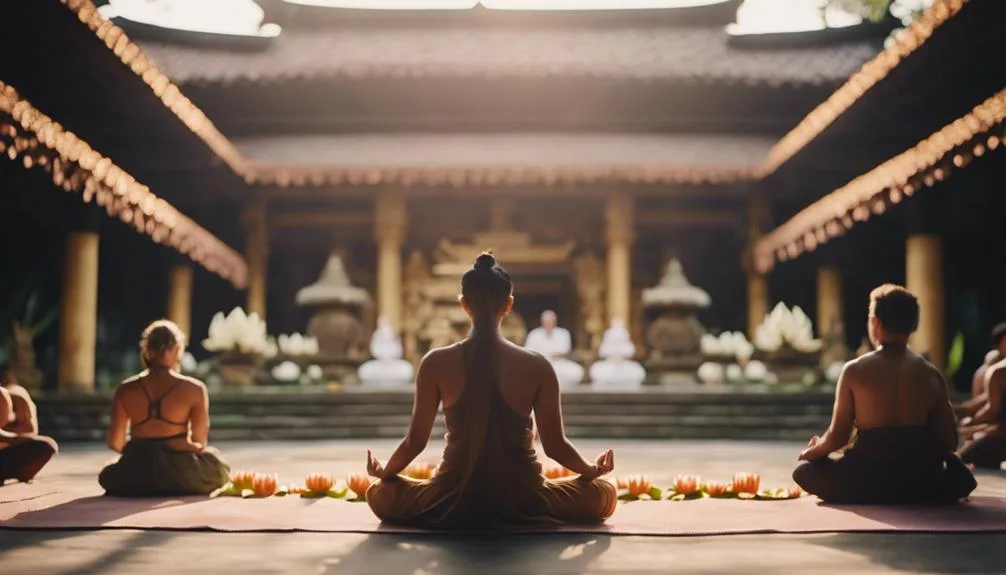Balinese Hinduism's Approach to Mindfulness Meditation
You might think that mindfulness meditation is a concept only popularized by modern wellness trends, but Balinese Hinduism has practiced it for centuries, integrating spirituality with daily life in a way that's both profound and accessible.
This approach isn't just about sitting quietly; it's a holistic practice that includes sacred rituals, engagement with nature, and the conscious movement of body and breath, all aimed at achieving harmony within oneself and with the universe.
By exploring these ancient techniques, you'll uncover how they offer a unique pathway to peace and well-being, inviting you to reconsider what mindfulness can mean in your life.
Key Takeaways
- Balinese meditation combines Hindu beliefs with native traditions, emphasizing balance and spiritual well-being.
- Sacred rituals and natural environments play crucial roles in enhancing meditation and mindfulness.
- Breathwork, mantras, and body movements are integral for achieving mental clarity and spiritual alignment.
- The practice fosters a deep connection with the divine, promoting inner peace and holistic well-being.
Understanding Balinese Mindfulness
Balinese mindfulness meditation, often integrating Hindu and indigenous beliefs, consistently focuses on achieving balance, harmony, and interconnectedness within oneself and the environment. This practice, deeply rooted in Hinduism, emphasizes a holistic approach to spiritual well-being, intertwining rituals, ceremonies, and a profound connection to the natural and celestial realms. It's not merely a method for relaxation or stress reduction; it's a way of life that influences daily activities, guiding practitioners towards a harmonious existence with the world around them.
You'll find that Balinese mindfulness meditation isn't a static practice. It evolves with the guidance of priests and holy figures, ensuring that it remains aligned with both personal spiritual needs and the cosmic order. The essence of this meditation lies in its ability to foster an environment where balance and harmony aren't just concepts, but lived experiences. Through dedicated rituals and ceremonies, it enhances spiritual awareness, allowing for a deeper sense of interconnectedness not only with one's inner self but also with the broader universe.
This approach to mindfulness, therefore, offers more than just inner peace. It provides a framework for understanding and interacting with the world in a more meaningful, balanced, and harmonious way.
Sacred Rituals and Meditation
Building upon the foundational principles of mindfulness in Balinese Hinduism, sacred rituals and meditation practices offer a pathway to deepen spiritual connections and achieve mental clarity. These practices aren't just mere routines; they're profound engagements that harmonize the body, mind, and spirit, facilitating a journey towards self-awareness and tranquility.
Here are three key aspects that highlight the significance of integrating sacred rituals and meditation in Balinese Hinduism:
- Focus on Breath and Mantras:
By concentrating on breathing and repeating mantras, you engage in a form of meditation that promotes inner peace and mental clarity. This focus helps in quieting the mind and increasing awareness, essential components of mindfulness.
- Cultivation of Mindfulness:
Sacred rituals often incorporate meditation as a method to foster mindfulness. This deliberate practice aids in deepening spiritual experiences, allowing you to connect more profoundly with your inner self and the divine.
- Harmonious Integration:
Balinese Hindu meditation practices emphasize the seamless integration of body, mind, and spirit. Through mindfulness techniques, you achieve a balance that enhances your spiritual connection and overall well-being.
The Role of Nature and Temples

In exploring the spiritual landscape of Bali, one can't overlook the profound role that both nature and temples play in enhancing mindfulness meditation practices. Temples, considered sacred spaces, offer tranquility and a unique connection to the divine, vital for deep meditative states. These spaces aren't just architectural marvels but are imbued with spiritual energy that facilitates a profound sense of peace and focus, essential for mindfulness meditation in Balinese Hinduism.
Nature, equally significant, serves as a backdrop that enriches meditation practices. The serene settings of rivers, forests, and mountains aren't mere locations but are integral to achieving a meditative state. The natural sounds of flowing water or rustling leaves aren't just auditory experiences but are utilized as aids in mindfulness practices, helping practitioners to anchor their attention in the present moment.
This deep-rooted belief in the interconnectedness with nature fosters a sense of unity and peace, which is central to the philosophy of Balinese Hinduism. It underscores the importance of both temples and the natural environment in creating a holistic approach to mindfulness meditation, highlighting how physical spaces can influence spiritual practices.
Breathwork and Body Movements
You'll find that Balinese Hinduism enriches its mindfulness meditation with pranayama techniques, emphasizing the role of breathwork in achieving mental and spiritual clarity.
By integrating sacred dance, these practices not only enhance mindfulness but also forge a profound connection between body, mind, and spirit.
This synergy between breathwork and body movements serves as a conduit to deeper spiritual alignment and holistic well-being.
Pranayama Techniques
Delving into Pranayama techniques reveals a sophisticated system of breathwork and body movements designed to optimize health and consciousness within Balinese Hinduism.
By engaging in controlled breathing, you're not only improving your energy flow and relaxation but also balancing your vital life force. This meticulous practice enhances your holistic health by fostering a robust mind-body connection. Here's how:
- Controlled Breathing: Fine-tunes your body's response to stress and promotes mental clarity.
- Energy Flow Regulation: Balances internal energies, leading to emotional stability and physical vitality.
- Vital Life Force Alignment: Strengthens your cognitive functions and emotional well-being through deliberate, rhythmic breath patterns.
These elements work in harmony to elevate your overall wellness, offering a profound sense of peace and heightened awareness.
Sacred Dance Integration
Building on the foundation of Pranayama techniques, Sacred Dance Integration introduces a dynamic layer to mindfulness meditation through its fusion of breathwork and expressive body movements in Balinese Hinduism. This intricate practice not only deepens your spiritual connection but also promotes a profound unity of movement, enhancing your mindfulness journey.
| Aspect | Description | Impact on Mindfulness |
|---|---|---|
| Breathwork | Focuses on controlling the breath to align with the divine energy. | Enhances present-moment awareness |
| Body Movements | Engages the entire body in fluid, expressive motions to embody the meditation. | Deepens sense of embodiment |
| Spiritual Connection | Bridges the physical and spiritual realms, facilitating a deeper spiritual awareness. | Fosters inner peace and connection |
| Unity of Movement | Harmonizes breath and movement for a holistic meditation practice. | Amplifies the meditative state |
| Cultural Significance | Rooted in Balinese Hinduism, provides a unique cultural and spiritual context. | Enriches the mindfulness experience |
This approach underscores the significance of harmonizing body and spirit, offering a pathway to tranquility and spiritual enlightenment.
Mantras and Chanting Practices

Mantras and chanting practices in Balinese Hinduism serve as integral components of mindfulness meditation, utilizing sacred sounds to facilitate deep mental focus and spiritual connection. These sacred utterances help you align with the divine, transcending the ordinary and embarking on a spiritual journey towards enlightenment.
Here's why these practices hold significant value:
- Deep Concentration: Chanting mantras aids in achieving a state of deep concentration. It's a practice that quiets the mind, allowing for enhanced focus and mindfulness. The repetitive nature of mantra chanting can lead you into a meditative state, fostering inner peace and facilitating spiritual growth.
- Transformative Effects: The repetition of specific mantras is believed to have transformative effects on your mind, body, and spirit. These mantras work on a vibrational level, aligning your energy with the frequencies of the universe and promoting healing and balance within.
- Connection with the Divine: By reciting mantras with intention and devotion, you can experience a profound sense of unity with the Divine and the cosmos. This practice isn't merely about the sounds themselves but the spiritual energies they invoke, paving the way for a deeper connection with higher consciousness.
Incorporating mantras and chanting into your meditation practice can significantly enhance your spiritual journey, offering pathways to inner peace and mindfulness through their transformative effects.
Community and Collective Meditations
In Balinese Hinduism, community meditations serve as a powerful conduit for unity and spiritual enrichment. They bring individuals together in temples and sacred spaces to share in the collective energy of mindfulness and devotion. These group gatherings aren't just about individual spiritual practice; they're deeply rooted in the principles of unity, harmony, and shared spiritual energy that are central to Balinese Hinduism.
Through chanting, prayers, guided visualizations, and offerings to deities, participants weave a tapestry of collective consciousness that uplifts each individual while fortifying the group's spiritual connection.
Participation in these communal meditative practices fosters a profound sense of belonging, connection, and support among members of the Balinese Hindu community. It's this shared experience of mindfulness meditation in a group setting that enhances the overall spiritual atmosphere, making the collective consciousness palpable.
You'll find that the spiritual energy generated in these community meditations transcends the sum of its parts, creating a harmonious blend of individual and collective spiritual journeys. This unique aspect of Balinese Hinduism underscores the importance of community and collective efforts in achieving spiritual growth and unity.
Frequently Asked Questions
How Do Hindus Practice Mindfulness?
You'd practice mindfulness through yoga integration, mantra chanting, and daily rituals, connecting deeply with nature and personal deities. This spiritual discipline, alongside a sattvic diet, enhances your awareness and aligns actions with spiritual beliefs.
What Does Hinduism Say About Meditation?
Hinduism views meditation as a crucial step in your spiritual journey, offering mental clarity and inner peace as you seek divine connection. Sacred texts guide this enlightenment pursuit, deeply rooted in yogic traditions.
What Is the Meditation Technique in Hinduism?
In Hinduism, meditation techniques involve mantra chanting, yogic breathing, and chakra focus. Dhyana mudras and third eye meditations are key for spiritual awakening, with guided visualizations further enriching the practice, aiming for profound inner peace.
What Is the Concept of Bali in Hinduism?
In Hinduism, Bali is a spiritual powerhouse, where island spirituality, sacred ceremonies, and temple festivals blend. You'll find community rituals, ancestral worship, and agricultural cycles deeply entwined, drawing in spiritual tourism with its unique vibrancy.
Conclusion
In conclusion, Balinese Hinduism offers a unique approach to mindfulness, deeply intertwined with spiritual and cultural practices.
Remarkably, over 80% of Balinese people engage in daily offerings, a testament to the pervasive influence of these rituals in promoting mental well-being.
This holistic practice, emphasizing harmony with the divine, nature, and community through breathwork, mantras, and collective meditations, underscores the profound impact of religious and cultural traditions on mindfulness techniques.
Balinese mindfulness not only fosters personal tranquility but also strengthens communal bonds, showcasing the interplay between individual and collective spiritual practices.






